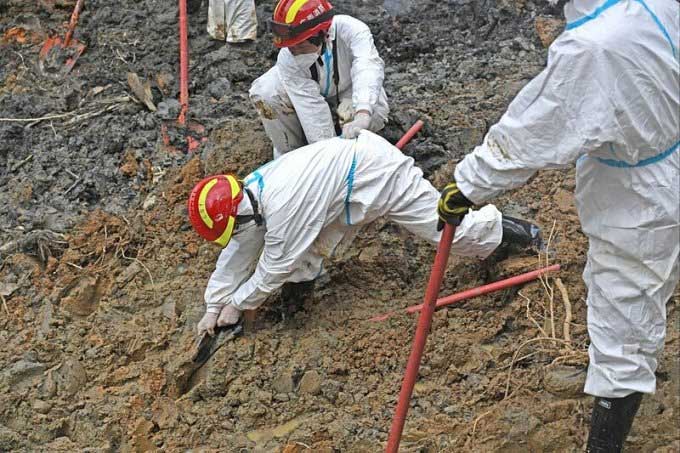Chinese officials confirm that all 132 people on board China Eastern Airlines flight MU5735, which crashed in Guangxi earlier this week, have died.
“All 123 passengers and 9 crew members on flight MU5735 of China Eastern Airlines were killed on March 21,” said Hu Zhenjiang, Deputy Director of the Civil Aviation Administration of China, as reported by state broadcaster CCTV today.
The announcement was made from the search and rescue command center in Wuzhou, Guangxi province, near the crash site, followed by a moment of silence for the deceased. Authorities have identified 114 passengers and 6 crew members through DNA testing.
Authorities have carefully preserved the remains and belongings of the victims and have established counseling teams for the families of those affected.

Rescue teams at the plane crash site in Guangxi, China on March 25. (Photo: Xinhua).
Flight MU5735 crashed in a mountainous area of Teng County, Wuzhou city, Guangxi Zhuang Autonomous Region on March 21. FlightRadar24 data shows that the aircraft plunged almost vertically from an altitude of nearly 9,000 meters. The pilots appeared to have attempted to regain altitude in the final moments, but the aircraft still struck the ground at a speed of nearly 600 km/h.
Zhu Tao, head of the aviation safety office at the Civil Aviation Administration of China, stated today that rescue workers had found the emergency locator transmitter, a device that continuously sends radio signals in the event of a crash. However, weather conditions at the site continue to hinder search and recovery efforts.
“Rescue and search operations face many challenges due to the impact of the crash and heavy rain, which increases the risk of landslides. We need to adjust our excavation plans,” Zhu said.
As of this afternoon, Zhu reported that 478 family members of 74 victims had visited the crash site. State broadcaster CCTV reported that a significant amount of debris was found today and that the direct impact point of the aircraft spanned 20 meters.
Zheng Xi, head of the Guangxi provincial fire department, indicated that 66 samples from the wreckage have been sent to laboratories for analysis, and among the 41 samples tested, there were no signs of conventional organic or inorganic explosives.
Zhang Qihuai, a researcher at the Aviation and Space Law Center of the China University of Political Science and Law, noted that each aircraft accident investigation is unique and complicated due to the differing location, time, state, and causes of each incident.
“Investigating this accident is extremely difficult,” Zhang said. “If the widely shared video online is true, the condition of the aircraft upon impact is so extreme that it’s hard to say whether the black box could withstand the impact.”
According to him, manufacturers, sellers, and operators of aircraft, as well as civil aviation regulatory agencies and the government, will participate in the investigation. They will work together to accurately and objectively reconstruct the circumstances leading to the accident, using data from the black box, the wreckage, and other evidence at the scene.
“It’s difficult to say how long it will take to produce a final report; there are too many factors to consider. It may take a long time, possibly several months to several years. There will also be various types of reports, such as preliminary, interim, and final,” the expert added.
The crash site of the Chinese plane viewed from above. (Video: CGTN).
- The mystery of the vertical plane crash in China: Experts also find it difficult to explain
- The process of decoding the black box of the crashed Chinese plane
- FlightRadar24: The failed ascent attempt of the Chinese plane carrying 132 people that crashed
- Pilot may have lost consciousness when the Chinese plane crashed “vertically”





















































